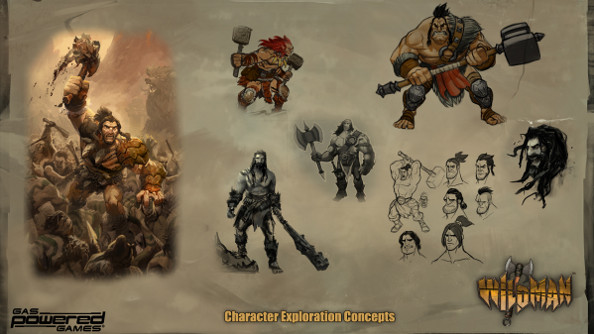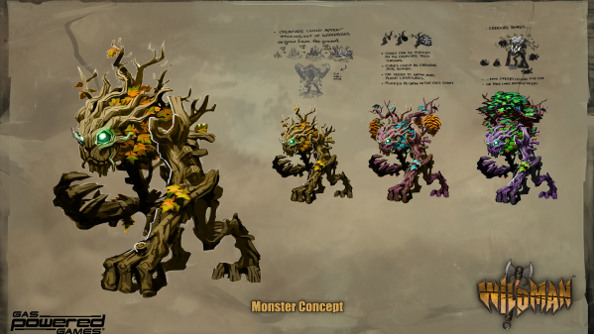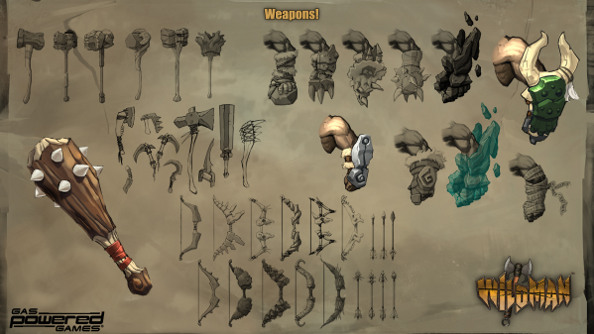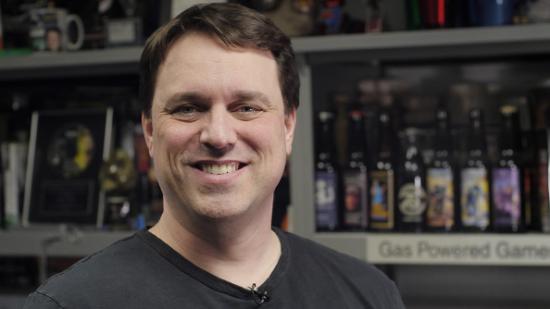Chris Taylor isn’t sleeping well. It’s Friday, January 11th, and there are only 72 hours until Gas Powered’s first Kickstarter goes live. He and his team at Gas Powered Games are constantly second-guessing themselves and worrying about the strength of their pitch for Wildman. Are they showing too little? They have prototype assets they can use, but they worry that the low-quality will make people think Wildman is likewise low-quality. But if they only show the stuff that looks good right now, chiefly concept art, Taylor and GPG worry that people will think the project looks too narrow, or too incomplete. How do you create a pitch that leaves people satisfied, yet hungry for more?
“You get one chance,” Taylor tells me. “And if you turn them off, you don’t get that second chance. We’re definitely worried because we know we can make fantastic visuals. It’s not a question of, ‘Can we?’ It’s a question of how thick do you want to spread the jam around on the bread?”
Taylor is one of the most accomplished and experienced designers in strategy, with genre classics like Total Annihilation and Supreme Commander to his credit, as well as the action RPG series Dungeon Siege. Gas Powered games also released a well-regarded MOBA, Demigod, and Age of Empires Online. Despite this pedigree, however, Taylor is nervous. He’s never gone directly to the public for funding before, and he increasingly feels this is the only way to make the kinds of games he has spent his career creating.
“It’s a different world than when I designed those other games,” he says. “It’s a world where publishers aren’t really interested in them. I don’t want to be mean, but if you call them up and say hey I’ve got an idea for a big PC game, they’re like GRRRROWLLLLBLEGH [this sounds like a hungover German shepherd].”
He understands why the business has changed. Publishers are losing money and getting ever more conservative. Risk-mitigation is the order of the day, but that’s just not the way Taylor works.
“You know the saying necessity is the mother of invention? I don’t know if it applies in this case. It seems like in this case necessity to avoid risk means there ain’t going to be a whole lot of stuff coming out. So we’re not down with that at all.”
No time for thinking
A few things happened to set Gas Powered on its new Kickstarter-powered course. First, Taylor was working on a platform for browser-based web gaming and realized he’d need a game to help sell gamers on the concept. He began toying around with a MOBA design, then his design roots asserted themselves and he started seeing ways to bring RTS elements into the game. Once the ideas started coming, they didn’t stop.
“It grew off the platform. It wasn’t going to be a good web game anymore. It was going to be a full-blown compiled C game. With all of the bells and whistles that you get when you’re in that environment. These are really true native apps on your machine. It grew into that. So we started working on that last fall. And we said this is most definitely going to be crowd funded and we’re here today.”

The cessation of development for Age of Empires Online provided the final impetus for Gas Powered to try something different. “It was a Microsoft decision. And we are supportive of them in terms of whatever they want to do. So they told us that they are going to be wrapping it up. And we have a fairly substantial team. A lot of our veterans were involved.
“Wildman at that same time was in development. So I said, ‘We can waste no time. We have to pull the trigger on this or not. There’s no time for gray area and for thinking.’ So we went for it and spooled up and began working on Wildman.”
Taylor admits, “If AoEO had not been ramped down, we’d still be working on that and Wildman would not be on the table today.”
Now that they’ve committed to Wildman and Kickstarter, however, Taylor doesn’t think he wants to go back.
“The old model just doesn’t work and it’s broken for so many different reasons that if this doesn’t work, we can’t go back,” he says. “It’s sort of like breaking out of the zoo. If you’re an animal, you can’t go back to the zoo. Not only can’t you go back, they don’t want you. That’s their point. After you’ve left, they’re like, ‘You’re a terrible zoo animal! Now you can survive out there in the world.’”
“A nice menu of crazy”
Taylor thinks Gas Powered is ready to survive outside publishers’ cages. He cites Age of Empires Online, in particular as an experience that got the studio ready to respond to the will of the crowd.
“We did a lot of that on AoEO. I think we were starting to get really good at it, because it does take a skillset and you have to really know how to talk to folks. You have to know that when someone comes across as really frustrated and angry, you have to know that they’re not really frustrated and angry. What they are is just hungry for answers. You go out there and say, ‘Okay guys, we have two ideas on the table and there’s only enough dollars to do one. However, if you want to go beat the bushes and generate the extra dollars to support it, we’ll go out and build them both.’”
Taylor is waiting to hear what the community wants for Wildman before he starts explaining where additional funding will go, and how resources will be divided. There are must-have features, but then there are also a series of “should-have” and “would be really nice to have” ideas that he wants feedback on.
“Now with Kickstarter, we have a crowd we can source questions to,” Taylor says. “We can kind of put it to them. What do you think of some of these ideas? If you believe that they’re too wacky and too ridiculous, since you’re the one who’s funding it, we’re gonna listen. And we really want to make sure that we have a nice menu of crazy for people to pick from, and then kind of massage the design around that.”

Taylor talks about enhancements like animated cutscenes in the single-player campaign (as opposed to comic-book style text bubbles) and having a live orchestra record the score for Wildman. But he also thinks they might be able to add some of the opponent heroes as selectable characters, so players don’t just control the Wildman or Wildwoman. Taylor is also waiting to see what the community decides with regard to multiplayer.
“I have this joke where the fanbase and the customers are saying, ‘We’d really like a solid single-player game, please,’ and the developers are like, ‘We’ll get right on that multiplayer game. We’ll give you nice PvP.’ There’s this total communication breakdown.”
Taylor wants Wildman to give players the fun RTS / MOBA experience the data says they, not the unforgiving competitive game that designers and hardcore gamers both seem to demand.
“The numbers have been consistent, not just the last five years but they go back 20 years, frankly, to when people could play multiplayer,” Taylor explains. “And the numbers are like 10% of the people want to play a PvP style game, but most folks really just want to be left alone to learn the UI, to learn the controls, to really understand all the minutiae and subtleties of the game.”
The next priority for Taylor is to include co-op multiplayer against enemy heroes and, if there’s interest and funding, the final step with multiplayer is to open up full PvP.
Bringing more strategy to MOBA
While Wildman is not a typical MOBA, Taylor promises he’s not trying to reinvent the wheel. “The action in the war zones will feel a bit like League of Legends or any kind of arena style. The controls should be really comfortable. We’re not trying to reeducate people on approaching that style of game. The difference of course is that you can build structures and units will spawn out of those structures and jump into that war zone. We’re really doing something to bring those RTS elements that we really do love into it in a meaningful way.”
Taylor’s sees the traditional MOBA as being 90% tactics and 10% strategy, but he really wants to see if he can change the ratio a bit to make a game that’s more strategically interesting. The game planning begins with choosing what items and technologies to bring to the battlefield that you’ve earned during the campaign, and it continues with decisions about how to employ gold. Gold is used to plop buildings down on the map that can spawn more forces, or to churn out high-tech units that can churn through enemy defenses or creep waves. Deciding when and how to employ gold, and where to push, is one of the major conundrums Taylor foresees players facing. Putting the traditional rushing, booming, and turtling tactics of RTS games into play within a MOBA framework is what makes Taylor so confident that, “A new game is going to emerge from this.”

It also sounds like it might be a harrowing development process. Taylors knows that, “There’s no magic… there’s going to sweat equity, there’s going to be late nights and weekends and a lot of effort. Most developers will tell you they try to build a schedule and a plan around a 40 hour week so that they have the headroom to go and fight fires and manage against things that come out. You don’t plan on an 80 hour week. You go read any management book and they frown on that. But the truth is kind of going to have to be like that.
“Having said that, we also have millions of dollars invested in tools and technology that give us a bonus. Out of the gate we’ve got a lot more than we would have if we rented an office, and a bunch of guys showed up on Monday and said, ‘Okay let’s build a game.’ There’s a lot of interesting variables here. And it’s not like any other game we’ve ever made.”
